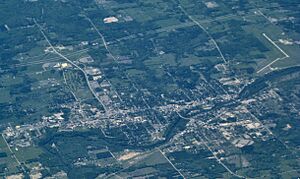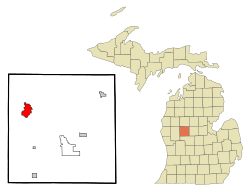Big Rapids, Michigan facts for kids
Quick facts for kids
Big Rapids, Michigan
|
|
|---|---|

Aerial photograph of Big Rapids in 2009
|
|
| Nickname(s):
"B.R."
|
|

Location of Big Rapids, Michigan
|
|
| Country | |
| State | |
| County | Mecosta |
| Incorporated | 1869 |
| Area | |
| • Total | 4.56 sq mi (11.82 km2) |
| • Land | 4.45 sq mi (11.51 km2) |
| • Water | 0.12 sq mi (0.30 km2) |
| Elevation | 925 ft (282 m) |
| Population
(2020)
|
|
| • Total | 7,727 |
| • Density | 1,738.36/sq mi (671.13/km2) |
| Time zone | UTC-5 (Eastern (EST)) |
| • Summer (DST) | UTC-4 (EDT) |
| ZIP code |
49307
|
| Area code(s) | 231 |
| FIPS code | 26-08300 |
| GNIS feature ID | 1619197 |
Big Rapids is a city in Michigan, USA. It is the main city and seat of government for Mecosta County. In 2020, about 7,727 people lived there. This number was lower than in 2010.
The city is surrounded by Big Rapids Charter Township. However, they are two separate places. Big Rapids is also home to Ferris State University. This is a public university where students can earn a four-year degree.
Contents
History of Big Rapids
Big Rapids was first settled in 1855. Two brothers, George and Zera French, started the settlement. It became the main city for Mecosta County in 1859. The village was officially planned out that same year. Big Rapids became a city in 1869.
Geography and Nature
Big Rapids covers about 4.48 square miles (11.6 square kilometers). Most of this area is land, with a small part being water. The ground here is sandy. This is because the area used to be an ancient seabed. Below the sand, there is a layer of iron ore.
The Muskegon River flows right through Big Rapids. It passes by Ferris State University and the local middle school. The river then continues on its way to Lake Michigan. There are also many small lakes close to the city.
Getting Around Big Rapids
There are several ways to travel in and out of Big Rapids.
Main Roads and Highways
Major highways that pass through or near Big Rapids include:
 US 131
US 131


 Bus. US 131
Bus. US 131 M-20
M-20 B-96
B-96
Bus Services
- Indian Trails offers bus service between Grand Rapids and Petoskey, Michigan. Buses stop in Big Rapids daily.
- The Big Rapids Dial-A-Ride provides local bus service. You can call them to arrange a ride.
Airports Near Big Rapids
- Roben-Hood Airport is just 2 miles (3.2 km) north of the city center. It serves local businesses and small planes.
- Gerald R. Ford International Airport is the closest international airport. It is about an hour's drive south, near Grand Rapids.
Trails for Cycling and Hiking
The Fred Meijer White Pine Trail goes through Big Rapids. This trail is 92 miles (148 km) long. It is used for cycling and hiking. The trail connects Grand Rapids to Cadillac.
Population and People
| Historical population | |||
|---|---|---|---|
| Census | Pop. | %± | |
| 1870 | 1,237 | — | |
| 1880 | 3,552 | 187.1% | |
| 1890 | 5,303 | 49.3% | |
| 1900 | 4,686 | −11.6% | |
| 1910 | 4,519 | −3.6% | |
| 1920 | 4,558 | 0.9% | |
| 1930 | 4,671 | 2.5% | |
| 1940 | 4,987 | 6.8% | |
| 1950 | 6,736 | 35.1% | |
| 1960 | 8,686 | 28.9% | |
| 1970 | 11,995 | 38.1% | |
| 1980 | 14,361 | 19.7% | |
| 1990 | 12,603 | −12.2% | |
| 2000 | 10,849 | −13.9% | |
| 2010 | 10,601 | −2.3% | |
| 2020 | 7,727 | −27.1% | |
| U.S. Decennial Census | |||
Changes in Population
Big Rapids had its largest population in the 1980s. Since then, the number of people living in the city has decreased. One reason for this is fewer students attending Ferris State University.
Population in 2020
In 2020, there were 7,727 people living in Big Rapids. There were 3,085 households. About 83% of the people were White. About 5.8% were African American. Other groups included Native American, Asian, and people of two or more races. About 5.1% of the population was Hispanic or Latino.
The average age in the city was 22 years old. Many residents, about 51.2%, were between 18 and 24 years old. This is likely due to the university.
Climate in Big Rapids
Big Rapids has a humid continental climate. This means it has big changes in temperature throughout the year. Summers are warm to hot and often humid. Winters are cold, sometimes very cold.
| Climate data for Big Rapids, Michigan | |||||||||||||
|---|---|---|---|---|---|---|---|---|---|---|---|---|---|
| Month | Jan | Feb | Mar | Apr | May | Jun | Jul | Aug | Sep | Oct | Nov | Dec | Year |
| Mean daily maximum °C (°F) | −3 (26) |
−3 (27) |
2 (36) |
11 (52) |
18 (65) |
24 (75) |
27 (80) |
26 (78) |
21 (69) |
14 (57) |
5 (41) |
−1 (30) |
12 (53) |
| Mean daily minimum °C (°F) | −12 (11) |
−13 (9) |
−8 (18) |
−1 (30) |
5 (41) |
11 (52) |
13 (56) |
12 (54) |
9 (48) |
3 (38) |
−3 (27) |
−8 (17) |
1 (33) |
| Average precipitation mm (inches) | 43 (1.7) |
41 (1.6) |
48 (1.9) |
69 (2.7) |
76 (3) |
79 (3.1) |
74 (2.9) |
74 (2.9) |
89 (3.5) |
71 (2.8) |
69 (2.7) |
43 (1.7) |
770 (30.4) |
| Source: Weatherbase | |||||||||||||
Famous People from Big Rapids
Many notable people have connections to Big Rapids:
- Matt Borland – A crew chief in NASCAR racing.
- Justin Currie – An NFL football player who grew up here.
- May Erlewine – A talented musician.
- Ben Hebard Fuller – A major general and former leader of the Marine Corps. He was born in Big Rapids.
- Clint Hurdle – A former MLB baseball player and manager. He was born in Big Rapids.
- James Hynes – A novelist who grew up in the city.
- Tom Shanahan – A sportswriter and author who also grew up here.
- Anna Howard Shaw – A leader in the women's suffrage movement. She lived in Big Rapids when she was young.
- Daisy Tapley – An African American classical singer, born in Big Rapids.
Education in Big Rapids
Big Rapids offers several schools and a university:
- Big Rapids Public Schools
- Crossroads Charter Academy
- Ferris State University
- St. Peter's Lutheran Church and School
- St. Mary's Catholic School
See also
 In Spanish: Big Rapids para niños
In Spanish: Big Rapids para niños



